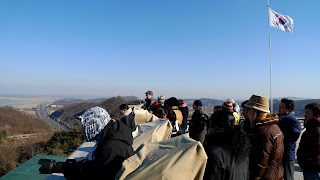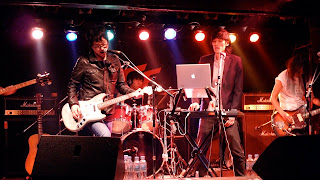Saturday, February 27, 2010
Club day in Hongdae
Move over boy and girl bands -- the Korean indie scene is alive and well in Seoul. Last night we went to see our friend's band play a gig as part of Hongdae's monthly "Club Day," where you can get into 21 clubs for the equivalent of $18.
After trying out a couple other clubs, we spent most of the night at Club FF, where our friend's band TV Yellow was playing. Later in the night we saw 도원경 (Do Won Kyung), a famous female rocker in Korea. Do has been on the scene (and Korean TVs) for over 15 years, and the club was packed. She reminded me a little of Garbage's Shirley Manson -- a complete breath of fresh air after hearing Girls' Generation for the last 9 months straight.
Do played this song from 1997 last night:
Compare that song with Girls' Generation's biggest hit, "Gee," which topped the charts in Korea for nine-weeks straight:
Ugh, I could write a thesis just on how much those two videos say about gender in Korea.
Monday, February 15, 2010
The Dawn of Eco-lit
 My review of Margaret Atwood's environment catastrophe novel "The Year of the Flood" published in the JoongAng Daily.
My review of Margaret Atwood's environment catastrophe novel "The Year of the Flood" published in the JoongAng Daily.
Sunday, February 14, 2010
Sunday, February 7, 2010
Inside the DMZ: An eco-tour

This past Friday I had the opportunity to explore some of the rarely seen parts of the Korean DMZ. I was selected to go on a wetlands eco-tour sponsored by the Gyeonggi Tourism Organization and the Korean Marine Environment Management Corporation, a branch of the Korean federal government. Following are some of my reflections of the trip and photos.
On a brisk weekday morning, I boarded a tour bus in Southern Seoul along with a dozen or so other expats for the DMZ Wetlands Tour in honor of World Wetlands Day. I know something about wetlands after living in Korea for eight months -- they are both one of the most important ecosystems here and the most endangered. But while most of Korea's wetlands are facing "reclamation" and development, there is one place in the country where the land is left untouched: the demilitarized zone.
One of the women that led our tour -- Namu Lee, the manager of the coastal management team -- directed our attention to the land along the Han River fenced off by barbed wire on our way up to the DMZ. This area, she said, was only protected today because of its vicinity to the North. The pressure for development is overwhelming in the South, and the only thing protecting these animals and environments is the fact that the country is still at war. This was a common theme throughout the trip, as we watched vultures land in shells strewn fields and eagles glide over an observatory tower.
 Our first stop was the Odusan Unification Observatory where we immediately saw three young white-tailed sea eagles -- listed as endangered species level one in Korea. The eagles were hovering over the spot where the Han River (which flows through Seoul) meets the Imjin River (infamous for the 1951 Battle of the Imjin River).
Our first stop was the Odusan Unification Observatory where we immediately saw three young white-tailed sea eagles -- listed as endangered species level one in Korea. The eagles were hovering over the spot where the Han River (which flows through Seoul) meets the Imjin River (infamous for the 1951 Battle of the Imjin River).
Before us was North Korea and an ice filled river. This area is the only place in South Korea where you can see blocks of ice like this, a result of the tides churning the ice after coming from the Yellow Sea. This is how tidal flats are created -- an essential ecosystem for birds in particular. The rest of the rivers in South Korea have embankments, so you can't hear the crackle of the ice like you can here.
 Next we headed over to the Jangdan Peninsula, the starting point of the DMZ itself. As we drover over through the golden rice patties we saw six white-naped cranes and three red-crown cranes (level two endangered in Korea). They congregated in families along a dirt road. We didn't see anyone else around, aside from the occasional group of Korean soldiers. The cranes winter in this area, so while it was cold I was glad we got to see them. This was one of those times I wished I had a $10,000 camera kit with super zoom lenses. If you zoom in the photo below all of the way, you can sort of make out the red-crown cranes in the middle of the photo.
Next we headed over to the Jangdan Peninsula, the starting point of the DMZ itself. As we drover over through the golden rice patties we saw six white-naped cranes and three red-crown cranes (level two endangered in Korea). They congregated in families along a dirt road. We didn't see anyone else around, aside from the occasional group of Korean soldiers. The cranes winter in this area, so while it was cold I was glad we got to see them. This was one of those times I wished I had a $10,000 camera kit with super zoom lenses. If you zoom in the photo below all of the way, you can sort of make out the red-crown cranes in the middle of the photo. We climbed up a hill to an observation post along the Imjin River to get a better view of the peninsula. The entire river was lined with barbed wire.
We climbed up a hill to an observation post along the Imjin River to get a better view of the peninsula. The entire river was lined with barbed wire. To our north, we could see a camouflaged village in North Korea. It looked like a sand castle (below, far left). On October 17, 1995 North Korean troops swam from this village south to near the spot where we were standing. One of the soldiers was killed, the other escaped.
To our north, we could see a camouflaged village in North Korea. It looked like a sand castle (below, far left). On October 17, 1995 North Korean troops swam from this village south to near the spot where we were standing. One of the soldiers was killed, the other escaped. Looking toward the village, we could see the barbed wire border all along the river north. On our way to lunch at a village in the Civilian Controlled Zone near the DMZ we ran into a field full of Cineroeous vultures. The Korean soldier that accompanied us said that he wouldn't recommend going into the field where the vultures were -- American soldiers had used it for target progress and there were still a lot of gun and bomb shells in the field.
Looking toward the village, we could see the barbed wire border all along the river north. On our way to lunch at a village in the Civilian Controlled Zone near the DMZ we ran into a field full of Cineroeous vultures. The Korean soldier that accompanied us said that he wouldn't recommend going into the field where the vultures were -- American soldiers had used it for target progress and there were still a lot of gun and bomb shells in the field.
The tour wrapped up at the Chopyeongdo wetland where we had a great view of the Imjin River to the south.
 We saw a lot of water deer on the drive there, but it was hard to make out much wildlife on top of the hill. As we were leaving, a representative from the Gyeonggi Province government came to greet us and give us a going away present: natural soap.
We saw a lot of water deer on the drive there, but it was hard to make out much wildlife on top of the hill. As we were leaving, a representative from the Gyeonggi Province government came to greet us and give us a going away present: natural soap.
That's right -- grenade shaped natural soap with "DMZ" written on it. Probably the weirdest gift I've ever gotten and a good reminder of the contradictions that exist in the DMZ. It's one of the most peaceful areas of Korea, undisturbed by mankind for the most part, but very much a war zone.
If anyone's interested in seeing high-quality, close-up photos of the wildlife in the DMZ, check out the blog of my tour guide here.
Subscribe to:
Comments (Atom)



